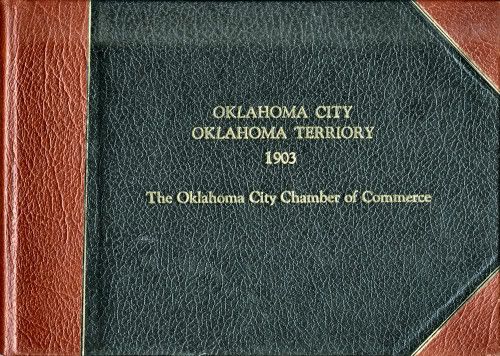
It is a thorough treat and honor when I have the opportunity and privilege to write an article that is wholly unique to what is available elsewhere, and this is such an occasion. Some months ago, one of this blog's principal benefactors, Mr. Dean Schirf, Corporate Secretary of the Greater Oklahoma City Chamber of Commerce, kindly allowed me to borrow and scan what I'd like from a 1903 Oklahoma City Chamber of Commerce publication which was obviously intended to be transmitted to businesses located outside Oklahoma City and Oklahoma Territory as it then existed. The truth is, I'm waaay behind on publishing some new great Oklahoma City trains articles for which Dean has provided the fodder, but that will be coming very soon.
Incidentally, I took a small peep at this book in this September 2008 article but this one is the real deal.
All of the images contained in this article are courtesy of the Greater Oklahoma City Chamber of Commerce, and I again express my thanks for the courtesy and privilege of posting those images here.
INTRODUCTION. Jump back in time to 1903, 105 years ago. Oklahoma City was only 14 years old, barely pubescent. In that day, just as now, the Oklahoma City Chamber of Commerce was proactively involved in attracting people and businesses to Oklahoma City. This 1903 book is essentially a 250 or so page advertisement showing off Oklahoma City to the world, inviting any who would come to settle here. The glossy-paper book represents Oklahoma City putting its best foot forward to make such an invitation.
Aside from the copy which is in the possession of the Greater Oklahoma City Chamber of Commerce, it is quite possible that no other copies of this book any longer exist, or, if they do, they are probably in private collections. In modern times, until 2005, the Chamber itself did not have a copy. It came to have one by the sharp eye and courtesy of Jim Fentriss, as described by a memo that Dean wrote which is in the inside cover to the book (click on the image below for a larger image of Dean's memo):
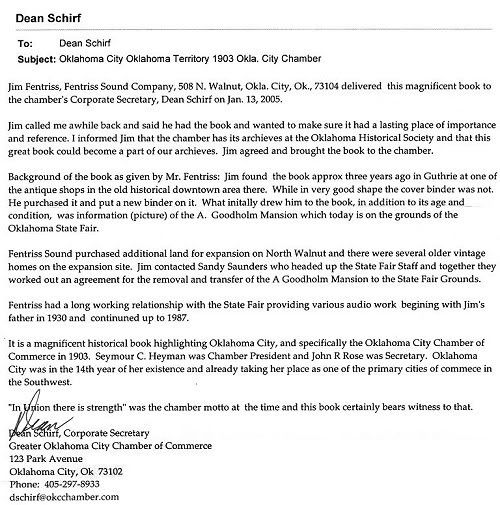
As this article is written, the book has not been donated to the Oklahoma Historical Society but remains in the hands and ownership of the Chamber.
The book was very well-done according to the standards and capabilities which existed in 1903. Printed on glossy paper, the images are somewhat grainy but better than the quality of images we'd see in newsprint, and, of course, some images are better than others. All images provide a marvelous look at Oklahoma City in 1903 and give occasional insight as to prevailing notions of what was socially permissible at the time.
This article contains all the images that I scanned and provides a few research notes I've done, as well, with an occasional image thrown in which is not in the book to help explain something or make it more relevant to a reader today. Each image which follows is a small version of a larger scan. Ordinarily, the 500 px wide versions I post link to 1024 px wide versions when an image is clicked. On this occasion, though, the linked images are significantly larger due to the historical value of this particular book. As usual, click on any image for a larger view which will open in a separate window or tab. Even though they will appear grainy, they should print better than an image which is 1024 px wide.
THE BOOK. As I said, the entire book is around 250 pages long (I neglected to make a note of the actual count), and I didn't scan them all. What follows are more than 60 pages that I did. Most pages are photographs but some contain text describing Oklahoma City in 1903. For the latter, to read the text, be sure to click on a the image to open a very readable view.
Aside from the inside cover (below), each page is numbered and page numbers for particular images are shown in the associated images below.
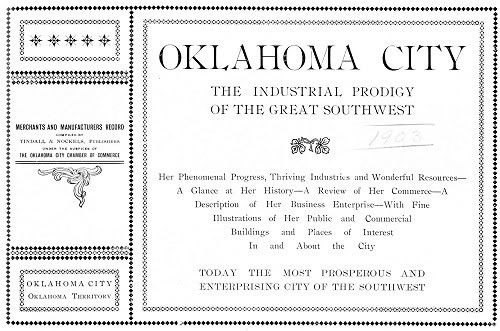
Page 2, North on Broadway From the Culbertson Building
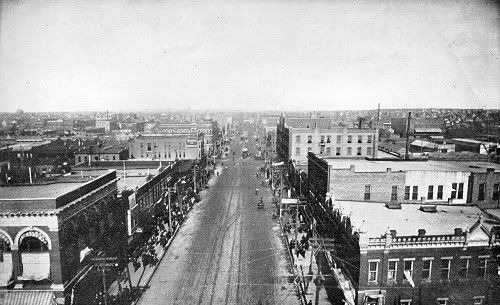
DL NOTES: Also, see page 47 (Culbertson Building) and page 139 (looking south to Culbertson Building.
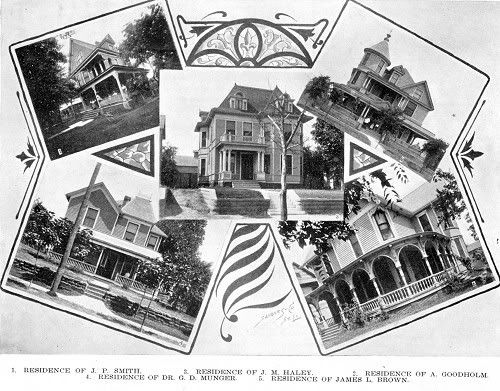
Page 10, Panorama From Emerson School at NW 6th & Walker, Looking Southeast Into the Warehouse District
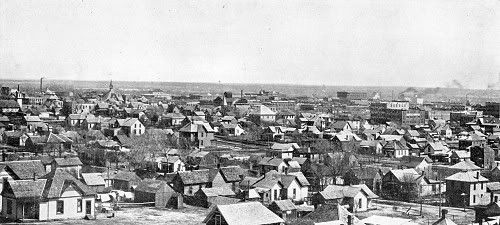
DL NOTES: The cropped and marked up image below below gives perspective. Couch Drive didn't exist then -- in the larger image you can make out the railroad tracks which were in that space; the location is shown for reference.
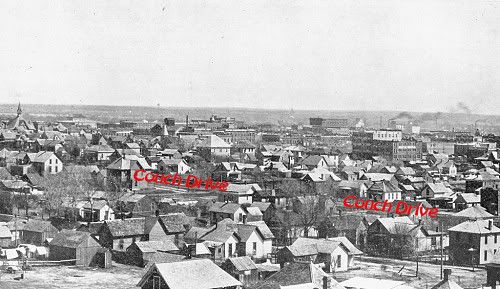
Page 11, Colcord Park located in Delmar Garden --
roughly south of Reno and west of Western, approximately where Farmers Market is today
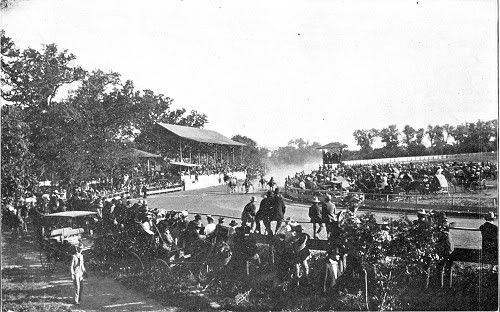
Pages 12, 14 & 16, About Oklahoma City

DL NOTES: A snippet from the above:
The business and residence area of the city covers about three square miles, half in the North Canadian valley and about half on the upland north of it, with the river forming almost a semi-circle around it. This area is closely covered by buildings of the best architecture and material. Main Street and Grand Avenue, running east and west, and Broadway and Robinson Streets, crossing them at right angles, comprise the principle business section, and for blocks are lined with two to six story brick buildings, the best of their kind in structure and design. Extensions are being made in every direction, and the large number of brick and stone buildings in course of erection at present add much to the substantial appearance presented by the city. The wholesale and manufacturing districts are spreading over a large territory to accommodate the new enterprises that are constantly being established in these lines. Hotels, churches, school-buildings, hospitals, etc., are a source of pride to the citizens, and the residence portions of the city display good taste and a keen appreciation of the artistic in building. The streets are laid with asphalt for a considerable distance from the business center, and work is being pushed as rapidly as possible to increase the paved area.
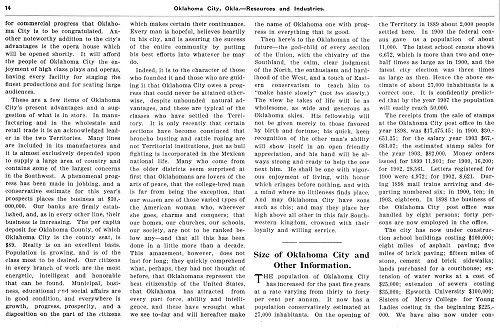
DL NOTES: A snippet from the above:
The population of Oklahoma City has increased for the past five years at a rate varying from thirty to forty per cent per annum. It now has a population conservatively estimated at 27,000 inhabitants. On the opening of the Territory in 1889 about 2,000 people settled here. In 1900 the federal census gave us a population of about 11,000. The latest school census shows 6,672, which is more than two and one-half times as large as in 1900, and the latest city election was three times as large as then. Hence the above estimate of about 27,000 inhabitants is a correct one. It is confidently predicted that by the year 1907 the population will easily reach 50,000.We didn't make the 50,000, but we did reach 32,452 by the 1907 Census.
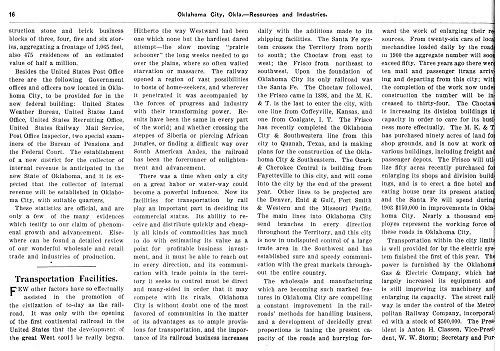
DL NOTES: A snippet from the above:
* * * Oklahoma City is without doubt one of the most favored of communities in the matter of its advantages as to ample provisions for transportation, and the importance of its railroad business increases daily with the additions made to its shipping facilities. The Santa Fe system crosses the Territory from north to south; the Choctaw from east to west; the Frisco from northeast to southwest. Upon the foundation of Oklahoma City its only railroad was the Santa Fe. The Choctaw followed, the Frisco came in 1898, and the M. K. & T. is the last to enter the city, with one line from Coffeyville, Kansas, and one from Coalgate, I. T. The Frisco has recently completed the Oklahoma City & Southwestern line from this city to Quanah, Texas, and is making plans for the construction of the Oklahoma City & Southeastern. The Ozark & Cherokee Central is building from Fayetteville to this city, and will come into the city by the end of the present year. Other lines to be projected are the Denver, Enid & Gulf, Fort Smith & Western and the Missouri Pacific. The main lines into Oklahoma City send branches in every direction throughout the Territory, and this city is now in undisputed control of a large trade area, in the Southwest and has established sure and speedy communication with the great markets throughout the entire country.
Page 13, Wheeler Park
East of Western, South of SW 9th
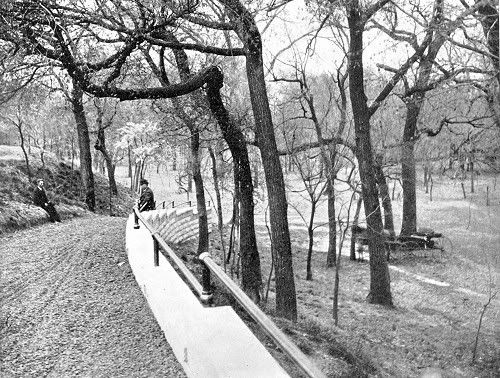
DL NOTES: Wheeler Park has been considered part of the Delmar Garden area even though it was not. The park was the home of Oklahoma City's first zoo. For more about Wheeler Park and Delmar Garden, see this article.
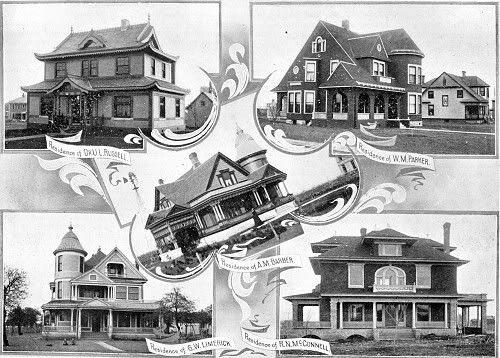
Page 17, Charles F. Colcord's Home, 421 N.W. 13th
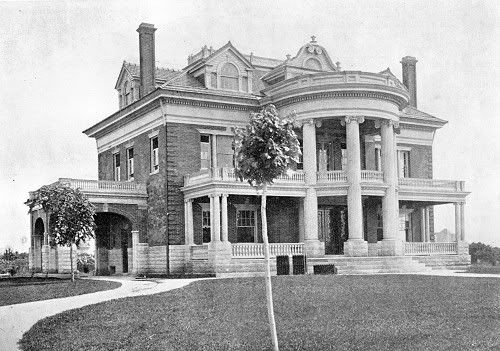
DL NOTES: This property was destroyed to make way for the property shown below (from County Assessor photographs):

Page 18, Carnegie Library & About Oklahoma City
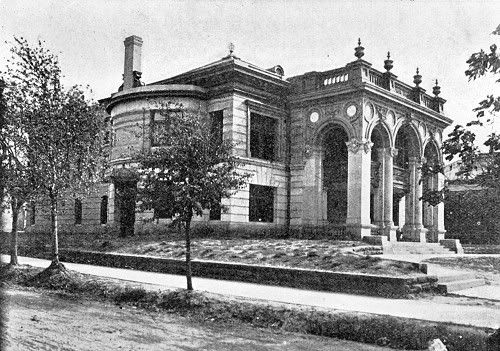
DL NOTES: The library was built in 1902 at the northeast corner of Northwest 3rd (now McGee) & Robinson. It was replaced by another library at the same location during 1953-54.
A snippet from pages 16-18 concerning OKC's trolley/interurban system:
Transportation within the city limits is well provided for by the electric system finished the first of this year. The power is furnished by the Oklahoma Gas & Electric Company, which has largely increased its equipment and is still improving its machinery and enlarging its capacity. The street railway is under the control of the Metropolitan Railway Company, incorporated with a stock of $500,000. The President is Anton H. Classen, Vice-President, W. W. Storm; Secretary and Purchasing Agent, J. W. Shartel; Treasurer, George H. Brauer; Superintendent, Charles W. Ford; Chief Electrician, Harry Sproull. The system is well equipped and its present trackage of about eight miles will be extended by the end of the year to fifteen miles.Well, it turned out not to be nearly as simple as that. OG&E's supply of power proved unpredictable, resulting in the Oklahoma Railway Company building its own power plant, Belle Isle (sources vary about the date but it was between 1907-1910). The interurban line to Guthrie was done (in 1916); the line to Purcell never happened but Norman did (Moore in 1910, Norman in 1913), as did a line to El Reno (1911), not mentioned in the Chamber's text. For more on this topic, see this earlier article.
Thirty miles of electric road will be built by the company newly organized to construct an interurban line from Oklahoma City to Guthrie. This is expected to be in operation within a year. Another interurban line is proposed, to run to Purcell, I. T., thirty-three miles from Oklahoma City.
There can be no hesitation in defining Oklahoma City's position as to advantages and importance in the matter of transportation. Every observer must admit that it would hardly be possible to find a record of greater progress than that presented by railway interests in this city.
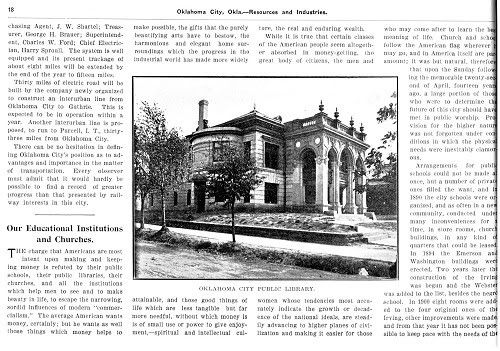
Page 19, Churches
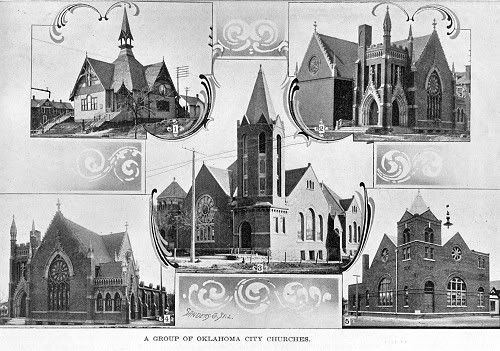
Page 20, About Oklahoma City
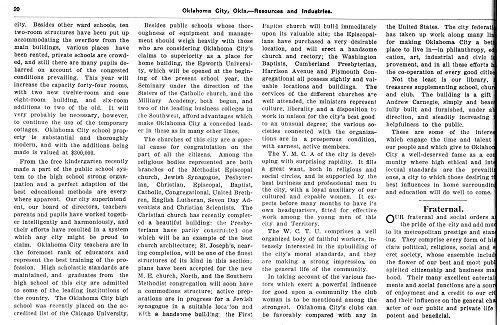
DL NOTE: A snippet from the above reads,
The W.C.T.U. comprises a well organized body of faithful workers, intensely interested in the upbuilding of the city's moral standards, and they are making a strong impression on the general life of the community.About this, I had to chuckle, given the other pages which touted Oklahoma City's liquor industry, as well as the Southern Club Bar! See pages 44, 48, and 184, below.
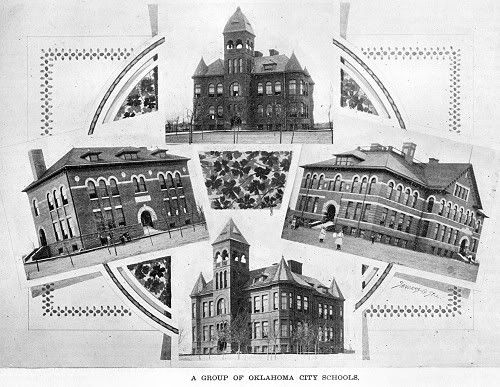
Page 23, City Hall,
Northwest Corner of Grand (Sheridan) and Broadway
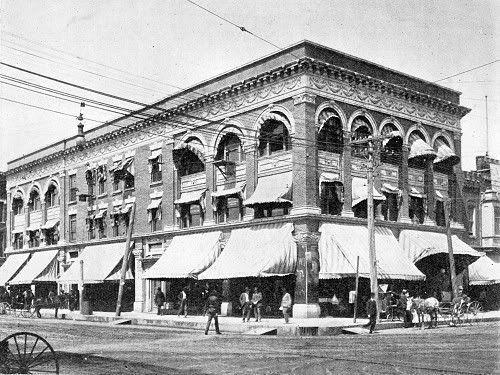
DL NOTES: This property remained City Hall until the current City Hall was constructed during the WPA days as part of Oklahoma City's "Civic Center" project in the mid-1930s.
Northwest corner of Broadway & Kerr
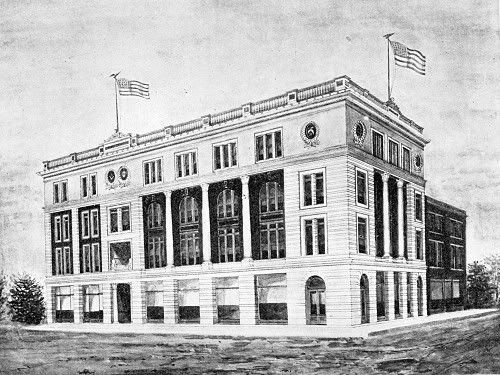
DL NOTES: The India Temple was built in 1902 and later became the Wright Building. This building still stands but is presently hidden under a false exterior at the the southeast corner of the SandRidge (formerly Kerr-McGee) campus. It served as the temporary location for the state legislature between 1913-1917, until the the State Capitol was completed. Hopefully, SandRidge will see the need to preserve and restore this very historic property.
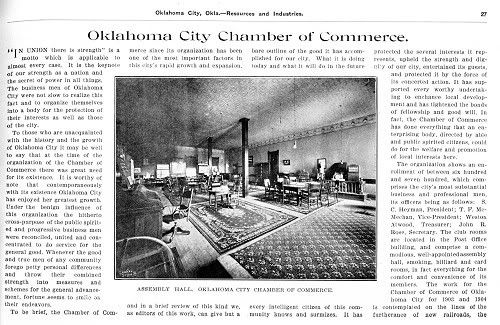

Page 29, Wholesalers
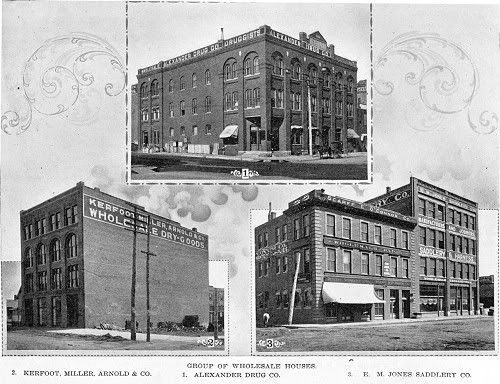
Page 35, Wholesale Grocers
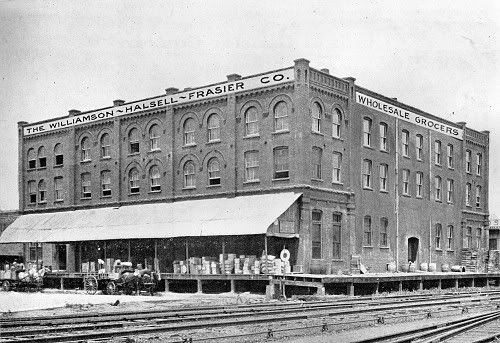
Page 39, Alexander Drug, NW 1st & Robinson
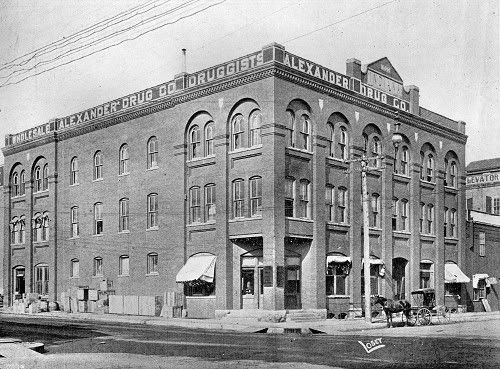
Page 44, McCarthy Wholesale Liquor, 26 W. Main
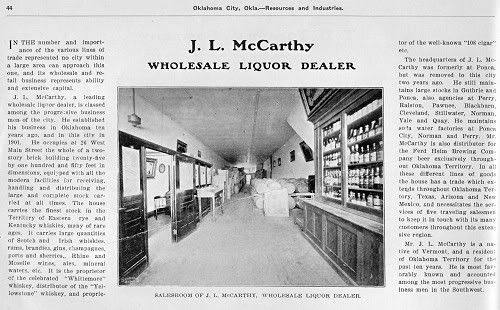
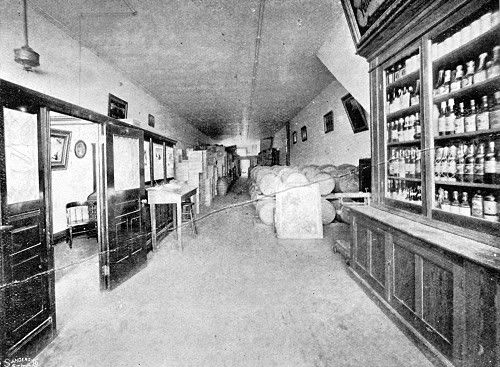
Page 47, Culbertson Building, built in 1902
at the "jog" on Broadway and Grand (now Sheridan)
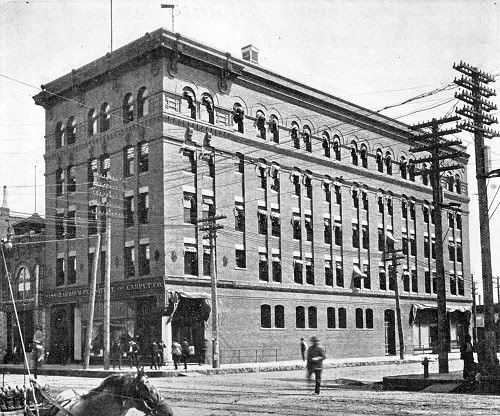
DL NOTES: Because it sat in the middle of southbound Broadway, the Culbertson Building was a favorite spot for photographs looking north. In photographs before the 1970s, it was seen with a Phillips 66 neon shield on its top. Also, see page 2 (top of Culbertson) and page 139 (looking south to Culbertson).
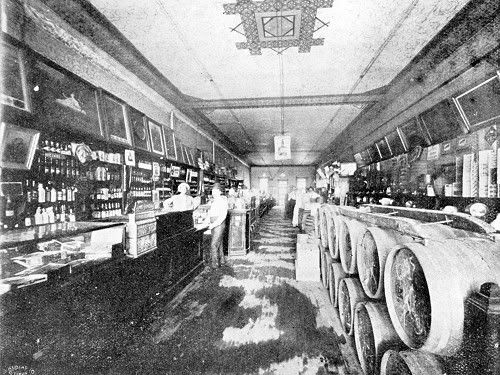
Page 53, Oklahoma Commerce Co., Reno by Santa Fe Tracks

Page 65, Western Union, 21 N. Broadway
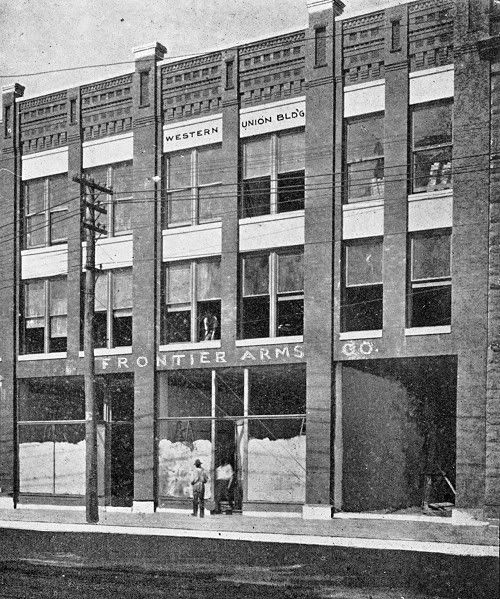
DL NOTES: This property was sandwiched in between the Herskowitz building to the south and the Patterson Building to the north ...


Page 76, Oklahoma Ice & Brewing Company (1902)
West of Santa Fe RR tracks on 2nd Street (R.S. Kerr Ave)
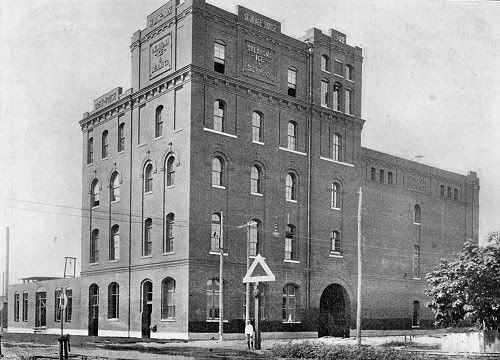
Page 88, Sherman Machinery, 18-32 E. Main
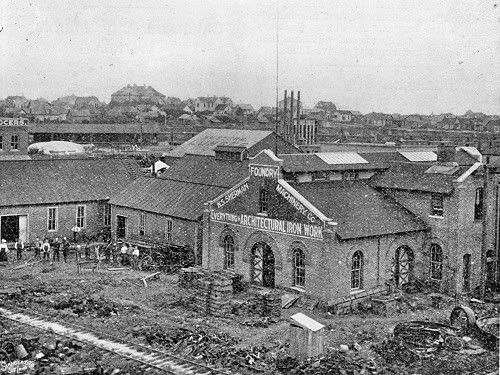
Page 96, Oklahoma Gas & Electric around Noble & Chickasaw by Santa Fe RR
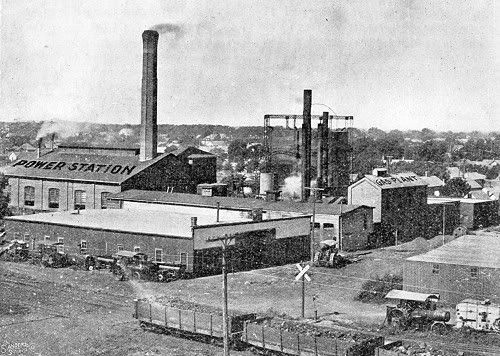
Page 102, Lee Building, Northeast Corner of Robinson & Main, but
this 1903 drawing isn't exactly the way the building turned out.
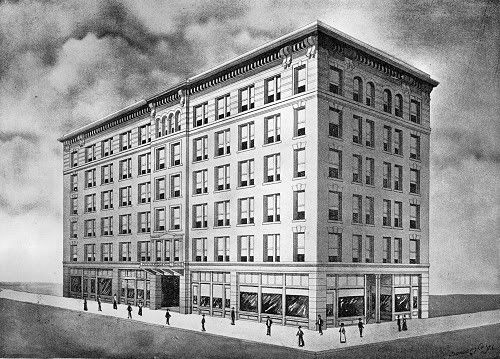
DL NOTES: Instead of the plans, the real Lee Building was 5 stories and wasn't built until a few years after 1903. The building which occupied the space burned down in late 1902 or early 1903 and housed the Lion Store before it moved to its 1903 location (see page 215, below). The actual building constructed, from another source, is shown below. The Lee Building later became the Oil & Gas Building and still stands although it is not recognizable from either of the images shown here. Today, the exterior is red brick and it houses Quiznos, among other tenants. Neil Horton saved this property from the Urban Renewal onslaught in the 1960s & 1970s. It was built by and named for Oscar G. Lee, OKC Police Chief (4/25/1892-4/12/1893) (only one of his many credentials -- see Page 153, Lee Hotel, below).

Page 107, Western National Bank, 101 W. Main
At the northwest corner of Broadway & Main,
it was originally the Masonic Temple built in 1893.
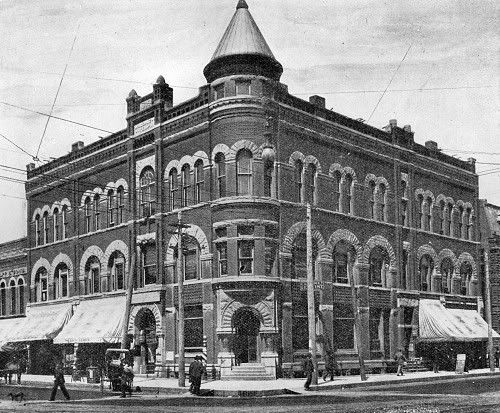
DL NOTE: For those who try to figure out "where buildings are" in early-day photos, this one is an important point of reference since it's the only building containing the distinctive turret shown above.
Southwest Corner of Main and Broadway

Page 120, Residences

Page 131, St. Anthony's Hospital, 1899 at 1000 N. Lee

For much more about St. Anthony's Hospital, go here.
The Lee Hotel is seen at the left.
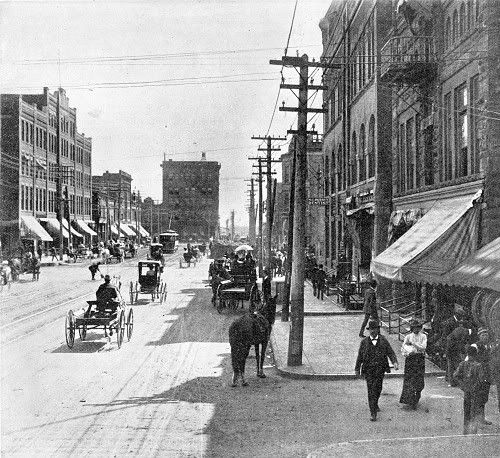
DL NOTE: Also, see page 2 (top of Culbertson) and page 47 (Culbertson Building).
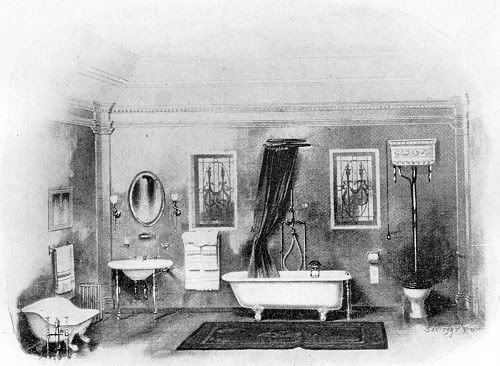
Page 147, Illinois Hotel, 219 W. Main

DL NOTES: Built in 1903, the Illinois Hotel became part of Brock's Dry Goods in 1914 or so, and, eventually, became part of the John A. Brown Department Store. See this article for the full story about that.

DL NOTE: What guy wouldn't rush right on down to Hanson's and buy a tub? The inclusion of a nude voluptuous lady in the Chamber's book speaks at least a little as to what was considered, "OK," in 1903! Don't bother to look for an ad like this in tomorrow's Oklahoman!
Northeast Corner of Broadway and 2nd (now R.S. Kerr)
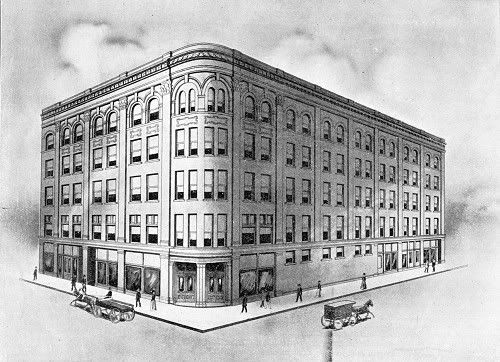
DL NOTES: Announced in 1903, this is another drawing that turned out differently than the completed product. When it opened in April 1904, it had 4 stories instead of 5 and was named for its owner, Dr. John Threadgill, as Hotel Threadgill. Later, it became the Hotel Bristol and survived under that name until early 1957 when it was razed to become a parking lot. In its early days, it was one of Oklahoma City's better hotels.
Approximately where the Courtyard Marriott is today
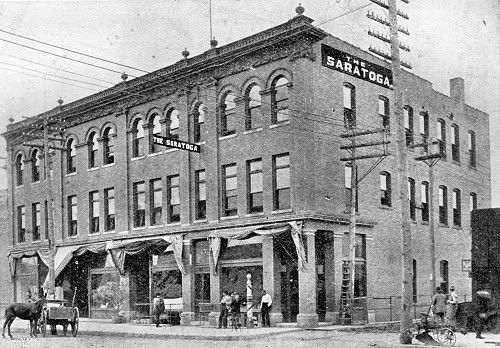
DL NOTES: This 45-room hotel doesn't appear to have ever been anything special; by the late 1940s it seems to have become the venue for several bootlegger arrests. It existed until at least 1975.
Northwest Corner of Broadway & Main
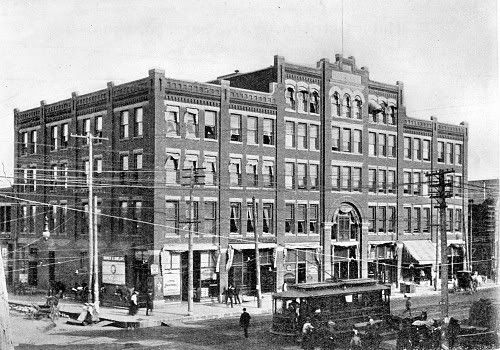
DL NOTES: The above was built by Oscar G. Lee in 1900. It was totally destroyed by fire in 1908 but was built anew as the 1910 Lee-Huckins Hotel at the same location. The Lee Hotel contained the city's 1st electric elevator and both Buffalo Bill Cody and Theodore Roosevelt were guests there. For much more about the Lee and its successors, go here.
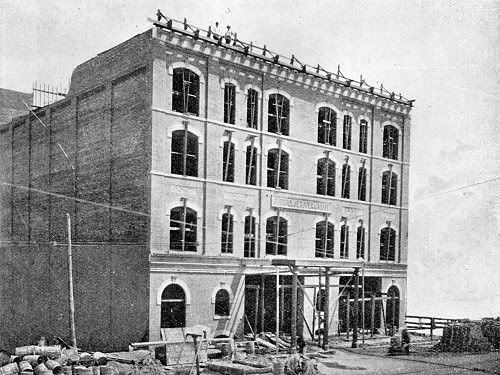
DL NOTES: Located at 217 W. Grand (a couple of buildings west of today's Colcord Hotel), notables as Sarah Bernhardt and Lillian Russell performed there. New owners acquired the building in 1917 and rebuilt it to become the Orpheum Theatre, opening as such in 1921. In 1928, being acquired by Warner Brothers, it became the Warner. In the mid-1950s, Warner Bros. renovated the building to become Oklahoma City's first Cinerama theater. It was destroyed in the mid-1960s. For a fuller story, go here.
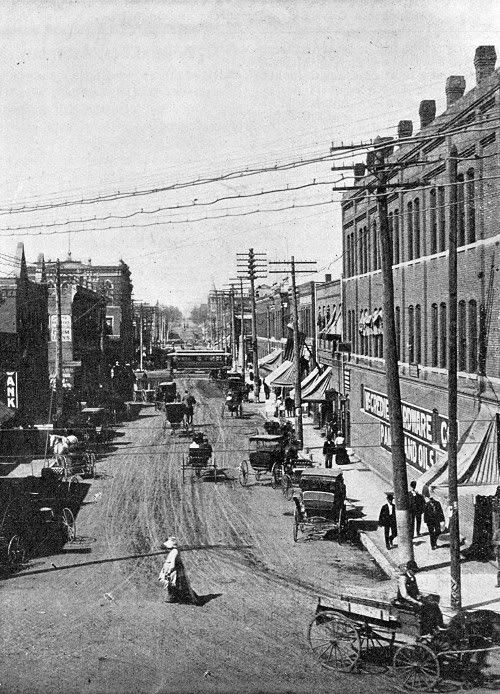
Page 171, Baptist Sanitarium, 227 E. 4th Street
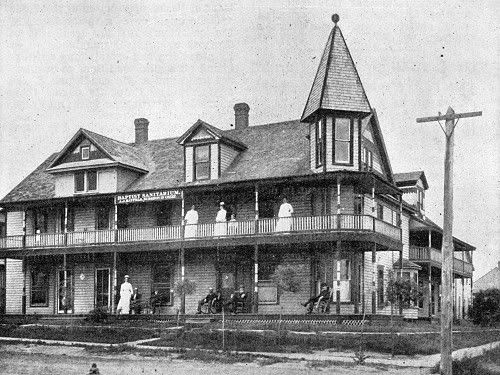
Page 177, Main Street, East From Harvey
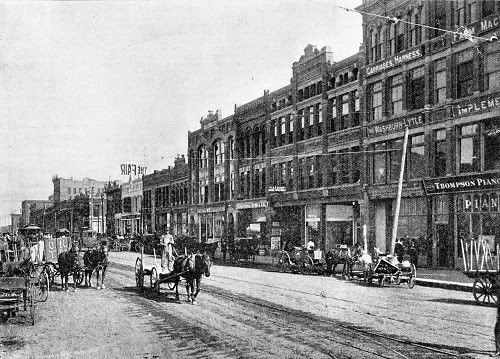
Page 184, The Southern Club Bar, 28 W. Grand
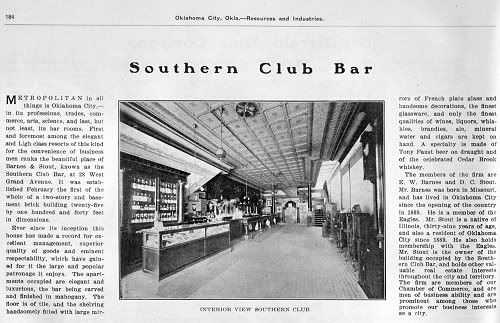
DL NOTES: Click on the above image to read all of the text, but a couple of excerpts read,
METROPOLITAN in all things is Oklahoma City—in its professions, trades, commerce, arts, science, and last, but not least, its bar rooms. First and foremost among the elegant and high class resorts of this kind for the convenience of business men ranks the beautiful place of Barnes & Stout, known as the Southern Club Bar, at 28 West Grand Avenue. It was established February the first of the whole of a two-story and basement brick building twenty-five by one hundred and forty feet in dimensions.You may know that the Southern Club was reputed to be one of the city's more elegant locations for vice, in those days gone by. One wonders how today's Chamber would describe such a gentleman's club, if at all!
Ever since its inception this house has made a record for excellent management, superior quality of goods and eminent respectability, which have gained for it the large and popular patronage it enjoys. The apartments occupied are elegant and luxurious, the bar being carved and finished in mahogany. The floor is of tile, and the shelving handsomely fitted with large mirrors of French plate glass and handsome decorations, the finest glassware, and only the finest qualities of wines, liquors, whiskies, brandies, ale, mineral water and cigars are kept on hand. * * * The firm [that owns the business] are members of our Chamber of Commerce, and are men of business ability and are prominent among those who promote our business interests as a city.
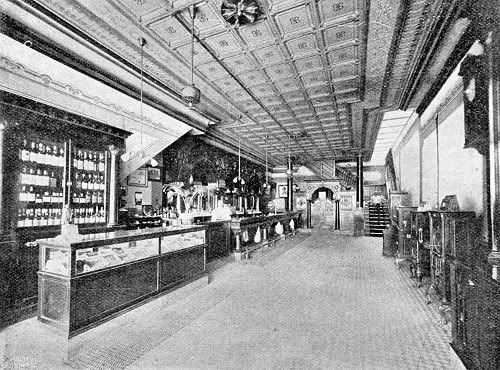
Page 189, Crescent Grocery, 207 W. Main
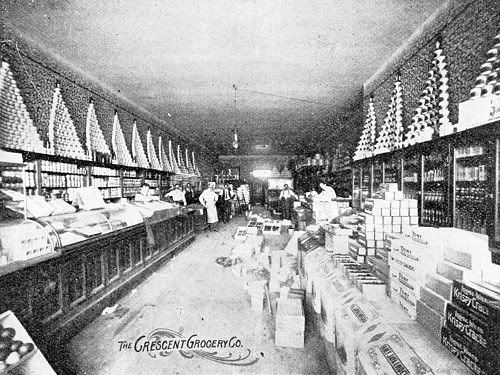
DL NOTE: When Plaza Court opened at Northwest 10th & Walker in 1927, Crescent Market became one of its initial tenants. See this article for more about that.
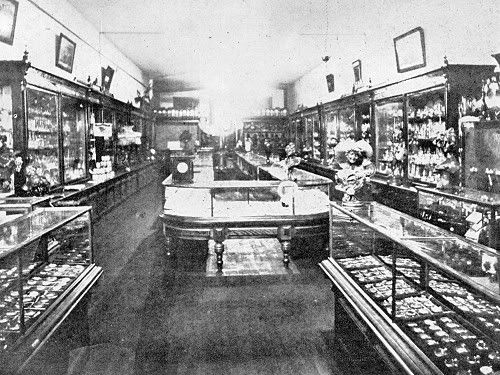
Page 194, Haleys Confectionary, 211 W. Main
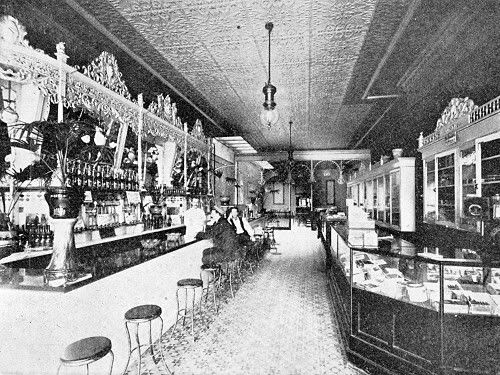
Page 197, Grand Avenue From Opera House
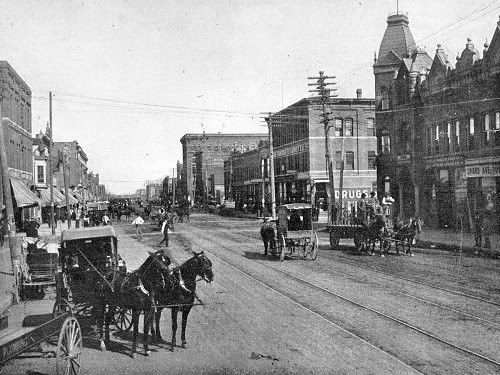
Page 215, The Lion Store, 124-126 W. Main
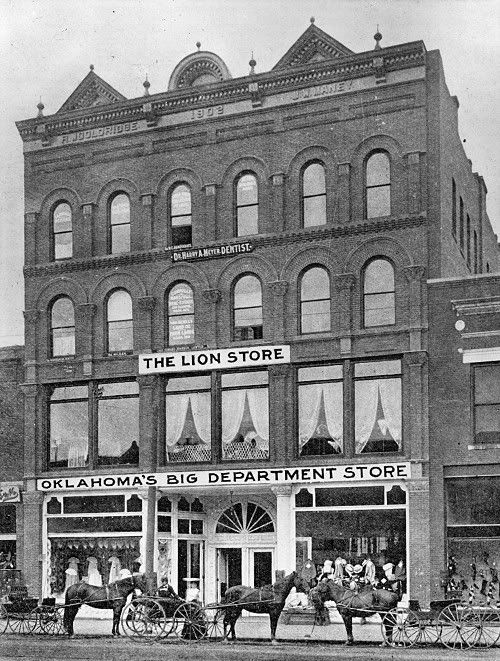
DL NOTES: The Lion Store was an early-day large dry goods store in Oklahoma City, operating between 1889 and 1937 under one owner or another. Following a fire at its location on the northeast corner of Main and Robinson (where the Lee Building would be built), the Lion Store moved into the above property. Later and by 1909, it moved to the corner of Broadway & Grand (Sheridan), the Culbertson Building, I'm rather certain. By 1909, the above building came to be known as the Empire Building, a couple of doors west of the Criterion Theater. A poor graphic from the April 22, 1910, Oklahoman shows the changed name but the picture after it of the Criterion shows it better:

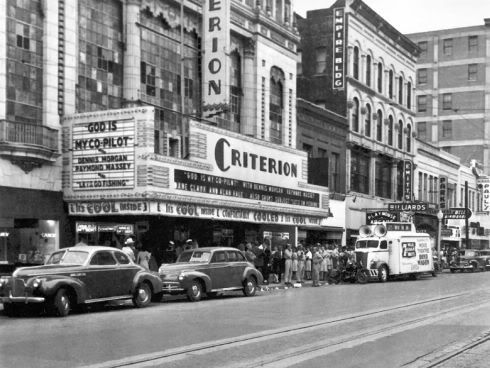
Page 217, Main Street From Broadway
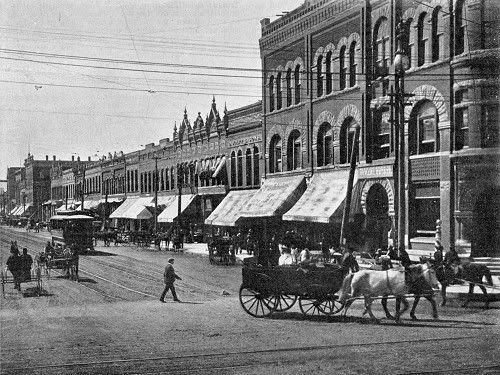
Page 224, Frisco Ad For The Ozark Route
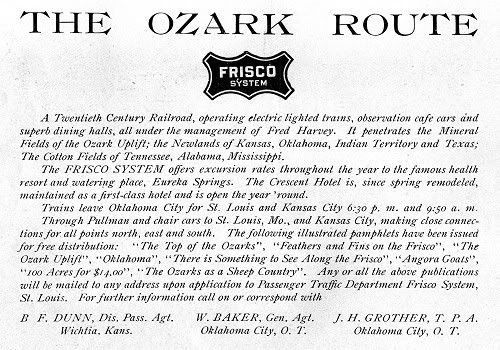
Page 225, Frisco Depot West of Hudson &
Around What Is Couch Drive Today

Page 227, Oklahoma State Military Institute
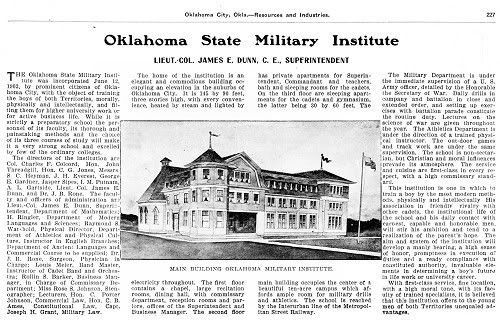
DL NOTES: I'll say more about this item since obscure puzzles interest me and, on research, I quickly discovered that this was precisely such a thing. As of this revision, I think that I've pretty well figured out most of the pieces.
The OSMI was located approximately a mile north of Epworth University upon a 10-acre tract of land ... this page at the Oklahoma City Metropolitan Library System places the location at NW 35th & McKinley but does not give a more precise location ... Jim Edwards & Hal Ottaways' Vanished Splendor (I), image 137, shows the location as NW 36th & McKinley. It was quickly put together in 1903 through the efforts and financial backing of several prominent Oklahoma Citians, including Dr. John Threadgill, C.F. Colcord, I.M. Putnam, C.G. Jones, and others. From the above sources, it was located within the circled area of a crop from a 1922 Sanborn Map Company map shown below:
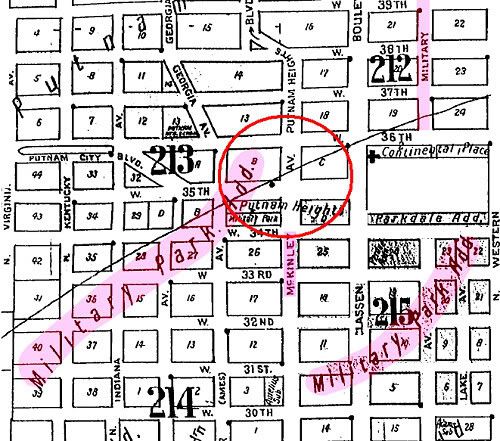
Notice that "Military Park Addition" spreads through this area and that Military Avenue exists as a north/south street. Perhaps you've wondered, "Why those names?" – the reason is doubtless the existence, though short-lived, of the Oklahoma State Military Institute.
When it opened, it was a true military institute, apparently a college-or-life preparatory school, for men only. It had its own canon and the cadets were equipped with Springfield rifles. Its commandant was appointed to serve by orders from the War Department. It was a self-contained facility which included a chapel, dining hall, sleeping rooms, gymnasium, and other elements appropriate for a boarding school. Cadets in the inaugural fall 1903 school term were reported by the Oklahoman to have come from 15 towns in Oklahoma and Indian Territories, one from Texas and another from Havana, Cuba. Its football team played at least one game (but I'd suppose more) as shown by this page from SoonerStats.com, winning 71-4. A March 12, 1939, Oklahoman article shows a picture of the 1904 OSMI team ...
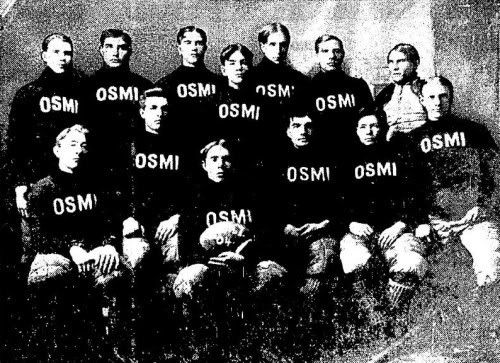
In any event, on August 6, 1905, an announcement in the Oklahoman stated that the successor institution to OSMI was "Capital University." Here's the August 1905 advertisement:
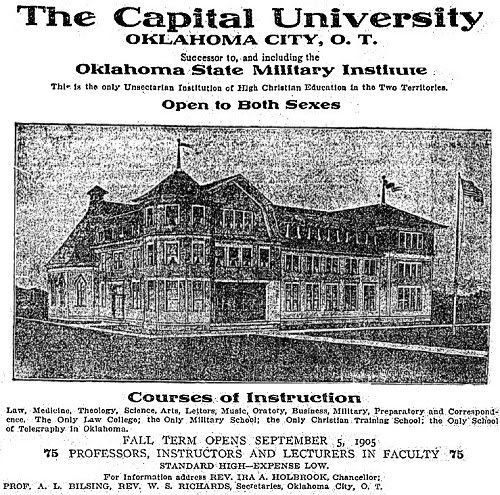
What's that? You never heard of "Capital University?" Neither had I until doing research through the Oklahoman's archives. It actually did exist but only for one year. I found no report of its demise in the Oklahoman's archives – the last reference I located mentioning this school was a January 4, 1906, snippet saying that its Chancellor, Rev. Ira Holbrook, was conducting a religious meeting in Wellston. After that, I found nothing about Capital University.
Instead of an article discussing Capital University, I located the July 4, 1906, advertisement below:

So, in July 1906, the building's occupant changed a third time, this time to an all-girls school. A postcard in Jim Edwards & Hal Ottaways' Vanished Splendor (I), image 137, shows "Oklahoma College For Young Ladies, Oklahoma City, Oklahoma" on the face of the card. The text associated with the card says that the school burned down in 1909. This page at MLS says that it burned down in 1909, but the source is the same volume of Vanished Splendor. A November 1, 1986, Oklahoman article, discussing the history of Putnam Heights Addition, contained a statement attributed to Warren Edwards, who, the article said, "saw the Oklahoma Military Institute near NW 35 and Classen burn in 1910." An August 14, 1936, Oklahoman obituary about Dr. G.C. Jones, founder of this school, said that the school was destroyed by a 1910 fire. Since I was unable to find any Oklahoman article describing a fire to this building, all that I can objectively say is that the fire occurred in 1909 or 1910.
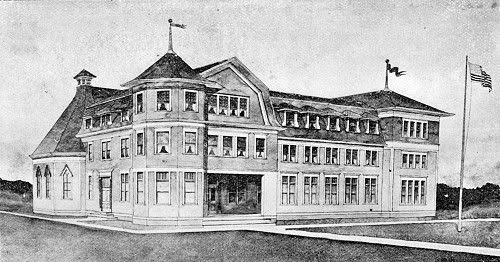
A real photo from the Oklahoma Historical Society
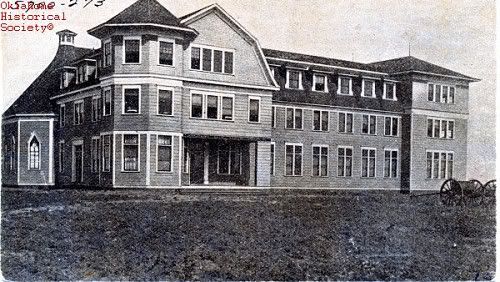

Page 231, Empire Laundry, 24 W. Main
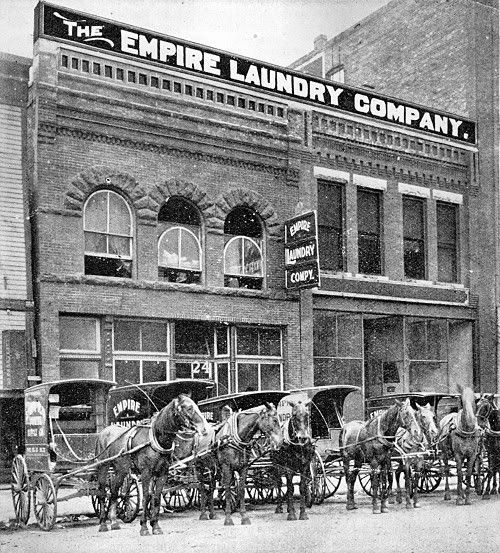
Page 239, St. Joseph's Cathedral Under Construction

That's all the scans I made and comments that I have, and I hope you enjoyed looking through this rare and excellent book and the various comments made along the way.













